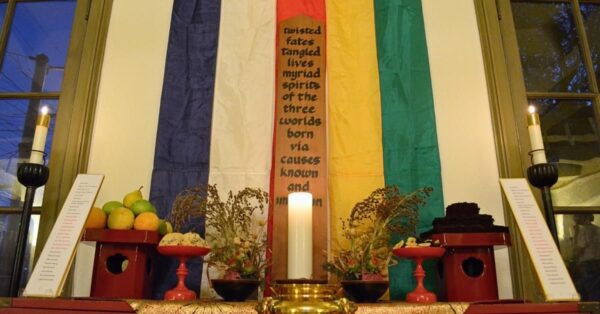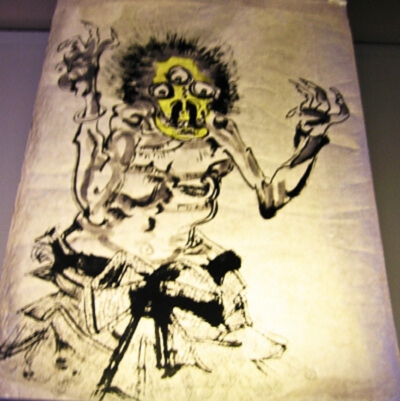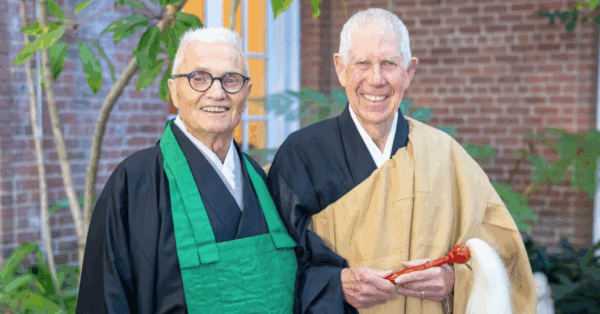
Sejiki altar in City Center’s Buddha Hall. Photo by Chris Shelton.
Friday, October 27 at 5:45pm
In the Buddha Hall, community dinner by donation to follow
(There will be no 5:40pm zazen)
Costumes are wholeheartedly encouraged but not required.
If you will be joining us for dinner, please click here to register by October 24.
The Sejiki (防餓鬼) ceremony, known as the Ceremony of Feeding the Hungry Ghosts, is an integral facet of the Soto Zen tradition. Rooted deeply in ancient Buddhist scriptures such as the “The Buddha’s Discourse on the Scripture of the Spell for Saving the Burning-Mouth Hungry Ghost” and the Ullambana Sutra, this ceremony illustrates the fate of the “Preta” or “Hungry Ghosts.” These spirits are trapped in an unceasing cycle of voracious desire, their emaciated forms and constricted throats visually portraying the relentless hunger they endure.

Hungry ghosts, illustration by Peter Bailey exhibited for the Sejiki ceremony at City Center.
In Buddhist cosmology, the realm of the Hungry Ghosts is one of the six realms of existence, each realm serving as a direct manifestation of beings’ karma and actions. Traditionally held during the seventh lunar month, the Sejiki ceremony, especially prominent during what’s colloquially called the “Ghost Month” in many East Asian cultures, seeks to honor and provide solace to these tormented spirits.
At SFZC’s City Center, the Buddha Hall is transformed to reflect the spirit of the occasion. Decorations consist of images of ghosts, demons, and other symbolic figures. Participants often wear masks or costumes, making the atmosphere simultaneously eerie yet brimming with presence. The intent is to make the realm of the living more accessible and less intimidating for those in the realm of Hungry Ghosts. Instead of the usual grand altar, an inviting table is set at the back, abundant with food and water on ornate dishes—a feast for the spirits.

Illustration by Peter Bailey, exhibited for the Sejiki ceremony at City Center.
The ceremony commences with a procession with the presiding priest or doshi carrying a special staff with metal rings that sound as they strike the staff on the floor during the procession. As the procession enters the Buddha Hall, a cacophony of sound, from a mix of Tibetan horns, conch shells, and other instruments, fills the room. This is an invitation to all spirits, ensuring they are near and ready to receive the offerings. The entire ceremony, from its eerie sounds to its sincere chants, centers on the theme of compassion. The doshi’s proclamation, “Welcome, hungry ghosts. Be at ease … Receive the best food. Welcome. Be safe,” encapsulates this sentiment.
Senior Dharma Teacher Tenshin Reb Anderson has explained that the chants and rituals of the Sejiki ceremony are offered within the context of the Bodhisattva vow, which the entire ceremony attempts to embody. As the doshi offers food and water, chanting mantras and invoking powerful symbols from Buddhist teachings, there’s a profound sentiment of hope and solace. The ceremony acts as a bridge between realms, emphasizing the importance of compassion, mindfulness, and interconnection in the midst of life’s complexities.
The Sejiki ceremony stands not only as a ritual but also as a profound exploration into the intricacies of existence, suffering, and desire. It is an invitation to introspection, urging practitioners to be present, compassionate, and attuned to the interconnected tapestry of life. Through the Sejiki ceremony, one can traverse the realms of the living and the deceased, finding solace, healing, and a deepened understanding of our shared human experience.
While similar ceremonies are held in Japan during Obon, San Francisco Zen Center has held Sejiki around Halloween, a secularized religious tradition that acknowledges the dead and their continued connection to the living.
Costumes may be worn to the ceremony. Afterwards, there will be a dinner; please register by Tuesday, October 24 if you plan to stay for dinner. The suggested donation for dinner is $10 – $15.
There is a moment in the ceremony when the names of people who have died in the past year are recited. If you would like to have a name included in the ceremony, please email the City Center Ino at ccino@sfzc.org by Tuesday, October 24.











